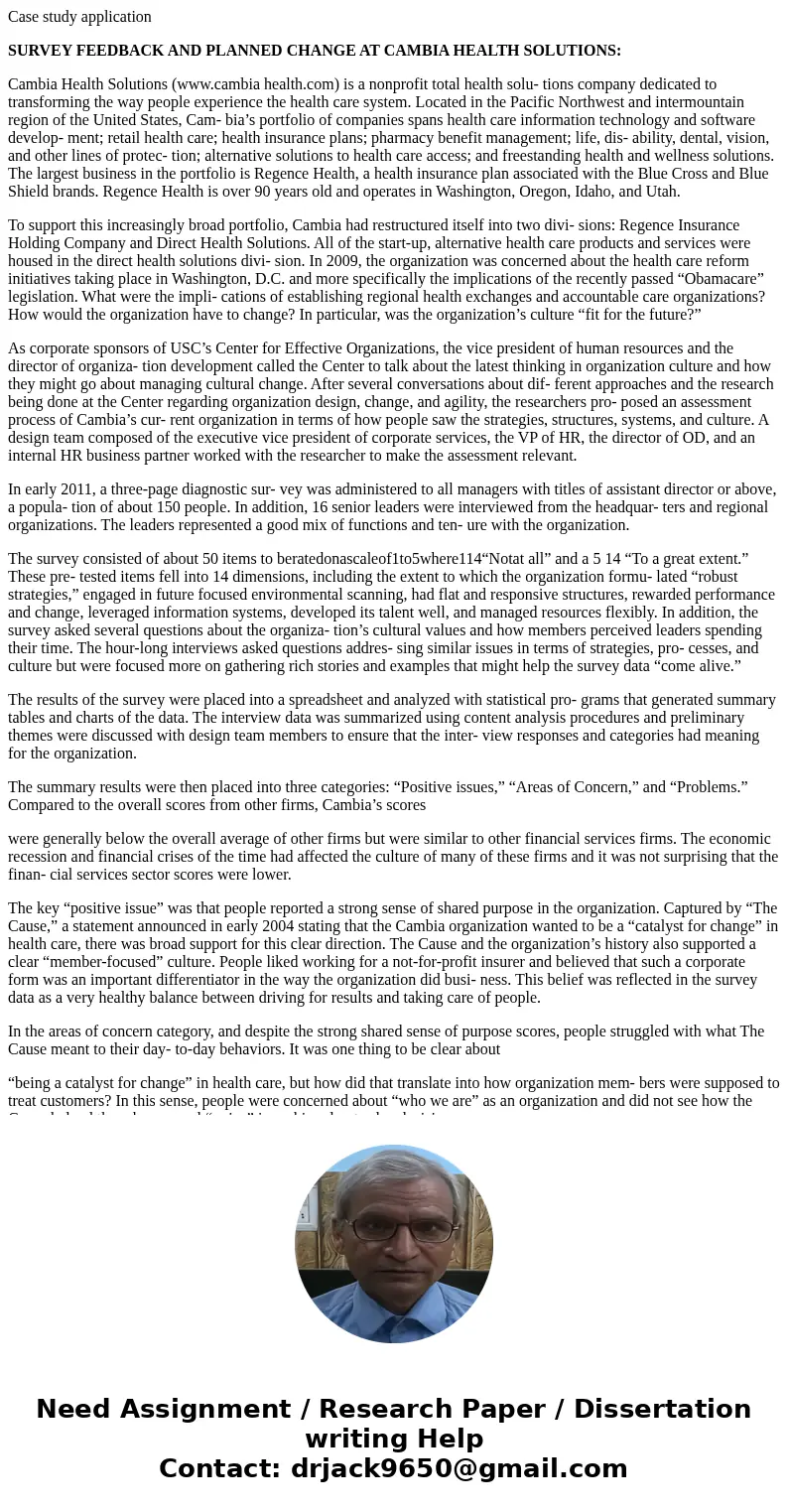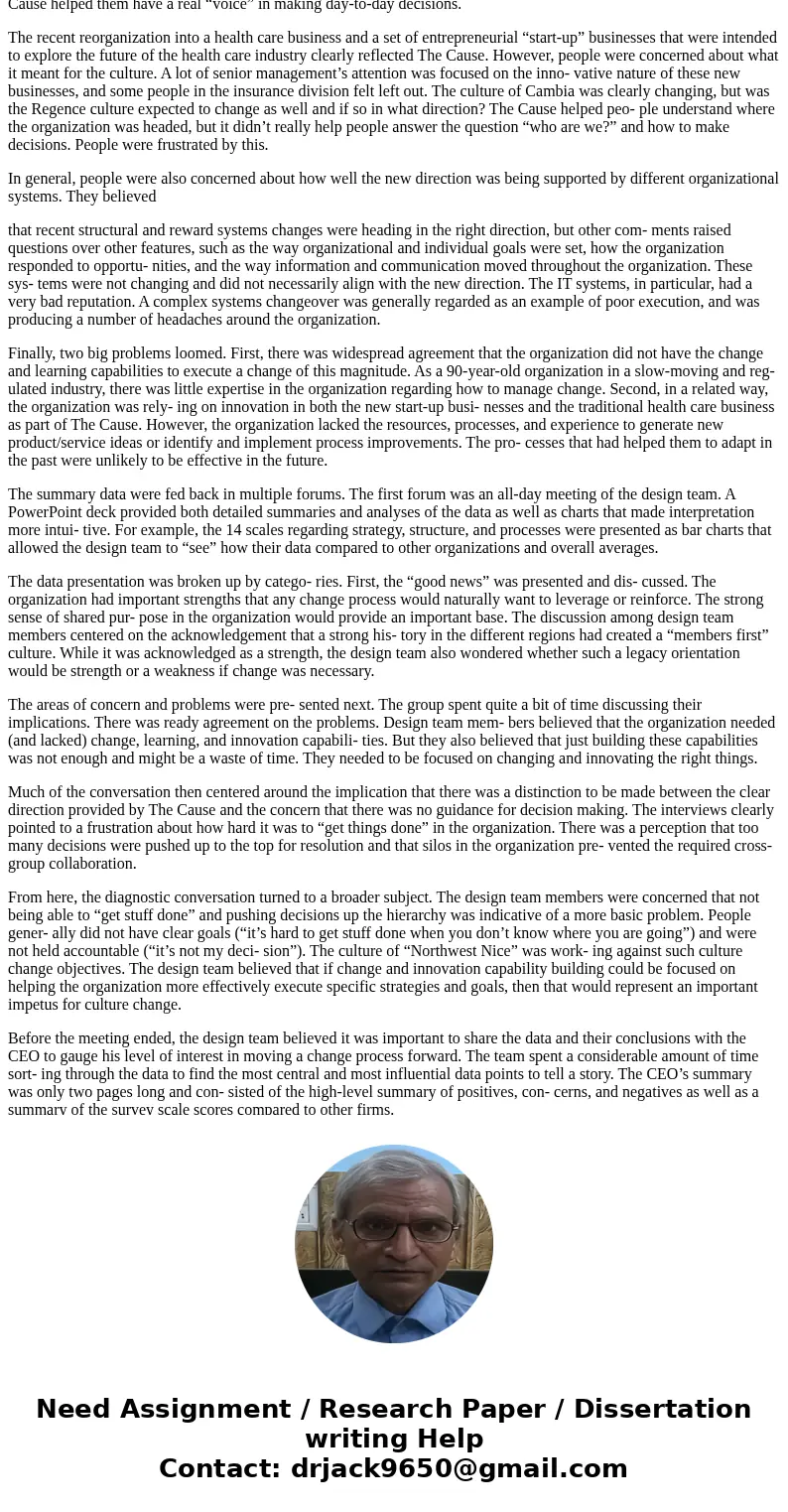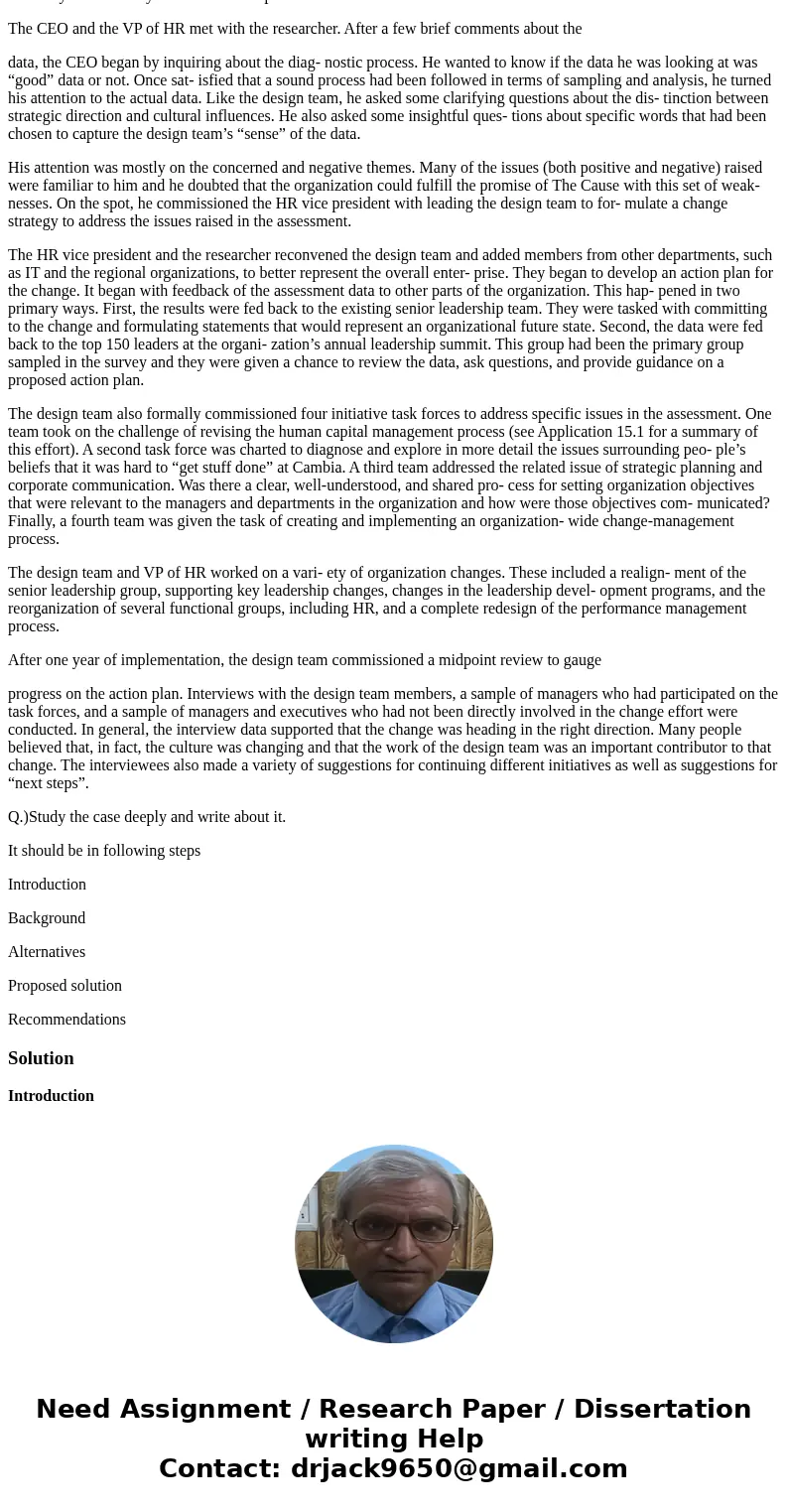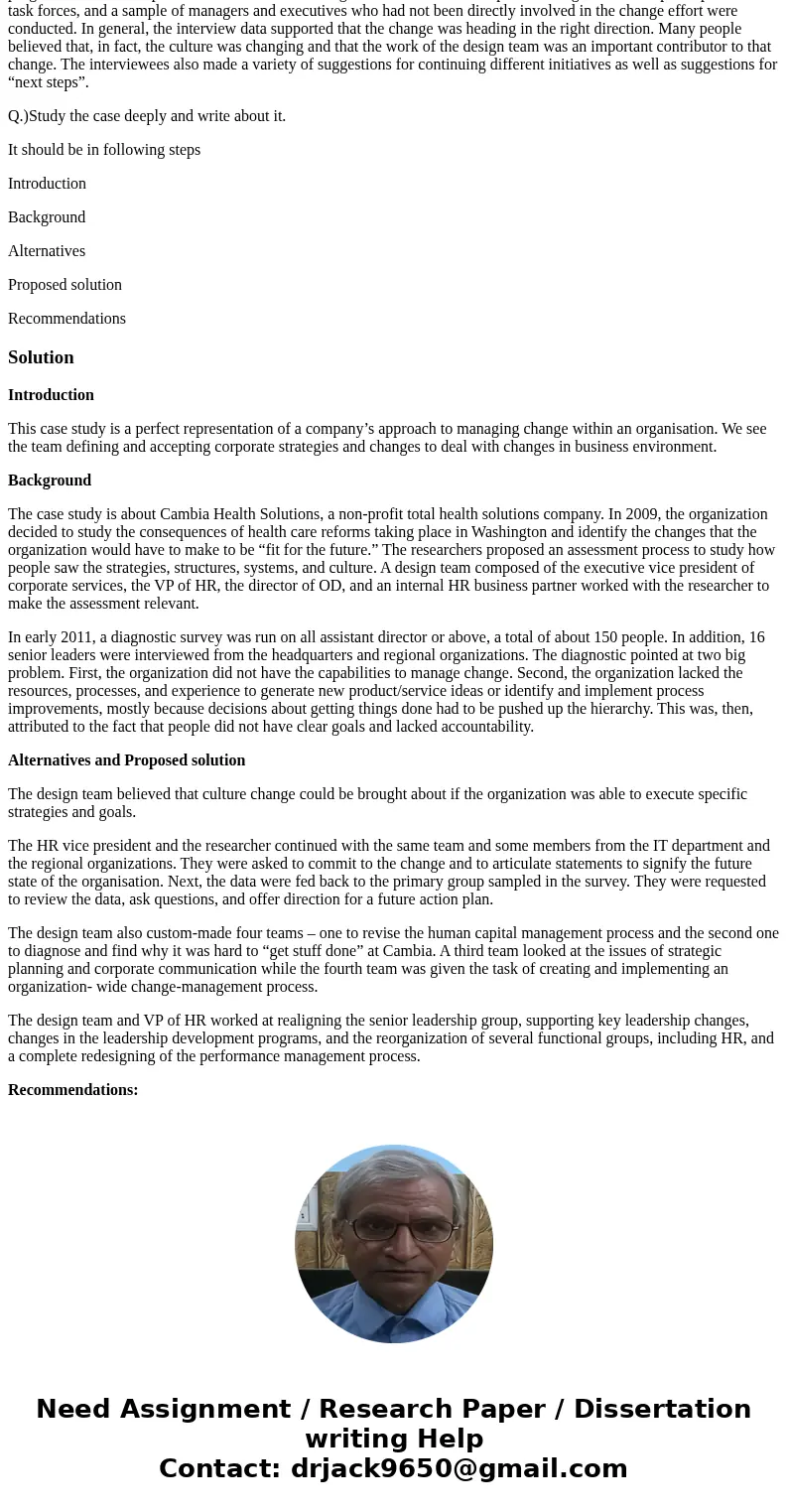Case study application SURVEY FEEDBACK AND PLANNED CHANGE AT
Case study application
SURVEY FEEDBACK AND PLANNED CHANGE AT CAMBIA HEALTH SOLUTIONS:
Cambia Health Solutions (www.cambia health.com) is a nonprofit total health solu- tions company dedicated to transforming the way people experience the health care system. Located in the Pacific Northwest and intermountain region of the United States, Cam- bia’s portfolio of companies spans health care information technology and software develop- ment; retail health care; health insurance plans; pharmacy benefit management; life, dis- ability, dental, vision, and other lines of protec- tion; alternative solutions to health care access; and freestanding health and wellness solutions. The largest business in the portfolio is Regence Health, a health insurance plan associated with the Blue Cross and Blue Shield brands. Regence Health is over 90 years old and operates in Washington, Oregon, Idaho, and Utah.
To support this increasingly broad portfolio, Cambia had restructured itself into two divi- sions: Regence Insurance Holding Company and Direct Health Solutions. All of the start-up, alternative health care products and services were housed in the direct health solutions divi- sion. In 2009, the organization was concerned about the health care reform initiatives taking place in Washington, D.C. and more specifically the implications of the recently passed “Obamacare” legislation. What were the impli- cations of establishing regional health exchanges and accountable care organizations? How would the organization have to change? In particular, was the organization’s culture “fit for the future?”
As corporate sponsors of USC’s Center for Effective Organizations, the vice president of human resources and the director of organiza- tion development called the Center to talk about the latest thinking in organization culture and how they might go about managing cultural change. After several conversations about dif- ferent approaches and the research being done at the Center regarding organization design, change, and agility, the researchers pro- posed an assessment process of Cambia’s cur- rent organization in terms of how people saw the strategies, structures, systems, and culture. A design team composed of the executive vice president of corporate services, the VP of HR, the director of OD, and an internal HR business partner worked with the researcher to make the assessment relevant.
In early 2011, a three-page diagnostic sur- vey was administered to all managers with titles of assistant director or above, a popula- tion of about 150 people. In addition, 16 senior leaders were interviewed from the headquar- ters and regional organizations. The leaders represented a good mix of functions and ten- ure with the organization.
The survey consisted of about 50 items to beratedonascaleof1to5where114“Notat all” and a 5 14 “To a great extent.” These pre- tested items fell into 14 dimensions, including the extent to which the organization formu- lated “robust strategies,” engaged in future focused environmental scanning, had flat and responsive structures, rewarded performance and change, leveraged information systems, developed its talent well, and managed resources flexibly. In addition, the survey asked several questions about the organiza- tion’s cultural values and how members perceived leaders spending their time. The hour-long interviews asked questions addres- sing similar issues in terms of strategies, pro- cesses, and culture but were focused more on gathering rich stories and examples that might help the survey data “come alive.”
The results of the survey were placed into a spreadsheet and analyzed with statistical pro- grams that generated summary tables and charts of the data. The interview data was summarized using content analysis procedures and preliminary themes were discussed with design team members to ensure that the inter- view responses and categories had meaning for the organization.
The summary results were then placed into three categories: “Positive issues,” “Areas of Concern,” and “Problems.” Compared to the overall scores from other firms, Cambia’s scores
were generally below the overall average of other firms but were similar to other financial services firms. The economic recession and financial crises of the time had affected the culture of many of these firms and it was not surprising that the finan- cial services sector scores were lower.
The key “positive issue” was that people reported a strong sense of shared purpose in the organization. Captured by “The Cause,” a statement announced in early 2004 stating that the Cambia organization wanted to be a “catalyst for change” in health care, there was broad support for this clear direction. The Cause and the organization’s history also supported a clear “member-focused” culture. People liked working for a not-for-profit insurer and believed that such a corporate form was an important differentiator in the way the organization did busi- ness. This belief was reflected in the survey data as a very healthy balance between driving for results and taking care of people.
In the areas of concern category, and despite the strong shared sense of purpose scores, people struggled with what The Cause meant to their day- to-day behaviors. It was one thing to be clear about
“being a catalyst for change” in health care, but how did that translate into how organization mem- bers were supposed to treat customers? In this sense, people were concerned about “who we are” as an organization and did not see how the Cause helped them have a real “voice” in making day-to-day decisions.
The recent reorganization into a health care business and a set of entrepreneurial “start-up” businesses that were intended to explore the future of the health care industry clearly reflected The Cause. However, people were concerned about what it meant for the culture. A lot of senior management’s attention was focused on the inno- vative nature of these new businesses, and some people in the insurance division felt left out. The culture of Cambia was clearly changing, but was the Regence culture expected to change as well and if so in what direction? The Cause helped peo- ple understand where the organization was headed, but it didn’t really help people answer the question “who are we?” and how to make decisions. People were frustrated by this.
In general, people were also concerned about how well the new direction was being supported by different organizational systems. They believed
that recent structural and reward systems changes were heading in the right direction, but other com- ments raised questions over other features, such as the way organizational and individual goals were set, how the organization responded to opportu- nities, and the way information and communication moved throughout the organization. These sys- tems were not changing and did not necessarily align with the new direction. The IT systems, in particular, had a very bad reputation. A complex systems changeover was generally regarded as an example of poor execution, and was producing a number of headaches around the organization.
Finally, two big problems loomed. First, there was widespread agreement that the organization did not have the change and learning capabilities to execute a change of this magnitude. As a 90-year-old organization in a slow-moving and reg- ulated industry, there was little expertise in the organization regarding how to manage change. Second, in a related way, the organization was rely- ing on innovation in both the new start-up busi- nesses and the traditional health care business as part of The Cause. However, the organization lacked the resources, processes, and experience to generate new product/service ideas or identify and implement process improvements. The pro- cesses that had helped them to adapt in the past were unlikely to be effective in the future.
The summary data were fed back in multiple forums. The first forum was an all-day meeting of the design team. A PowerPoint deck provided both detailed summaries and analyses of the data as well as charts that made interpretation more intui- tive. For example, the 14 scales regarding strategy, structure, and processes were presented as bar charts that allowed the design team to “see” how their data compared to other organizations and overall averages.
The data presentation was broken up by catego- ries. First, the “good news” was presented and dis- cussed. The organization had important strengths that any change process would naturally want to leverage or reinforce. The strong sense of shared pur- pose in the organization would provide an important base. The discussion among design team members centered on the acknowledgement that a strong his- tory in the different regions had created a “members first” culture. While it was acknowledged as a strength, the design team also wondered whether such a legacy orientation would be strength or a weakness if change was necessary.
The areas of concern and problems were pre- sented next. The group spent quite a bit of time discussing their implications. There was ready agreement on the problems. Design team mem- bers believed that the organization needed (and lacked) change, learning, and innovation capabili- ties. But they also believed that just building these capabilities was not enough and might be a waste of time. They needed to be focused on changing and innovating the right things.
Much of the conversation then centered around the implication that there was a distinction to be made between the clear direction provided by The Cause and the concern that there was no guidance for decision making. The interviews clearly pointed to a frustration about how hard it was to “get things done” in the organization. There was a perception that too many decisions were pushed up to the top for resolution and that silos in the organization pre- vented the required cross-group collaboration.
From here, the diagnostic conversation turned to a broader subject. The design team members were concerned that not being able to “get stuff done” and pushing decisions up the hierarchy was indicative of a more basic problem. People gener- ally did not have clear goals (“it’s hard to get stuff done when you don’t know where you are going”) and were not held accountable (“it’s not my deci- sion”). The culture of “Northwest Nice” was work- ing against such culture change objectives. The design team believed that if change and innovation capability building could be focused on helping the organization more effectively execute specific strategies and goals, then that would represent an important impetus for culture change.
Before the meeting ended, the design team believed it was important to share the data and their conclusions with the CEO to gauge his level of interest in moving a change process forward. The team spent a considerable amount of time sort- ing through the data to find the most central and most influential data points to tell a story. The CEO’s summary was only two pages long and con- sisted of the high-level summary of positives, con- cerns, and negatives as well as a summary of the survey scale scores compared to other firms.
The CEO and the VP of HR met with the researcher. After a few brief comments about the
data, the CEO began by inquiring about the diag- nostic process. He wanted to know if the data he was looking at was “good” data or not. Once sat- isfied that a sound process had been followed in terms of sampling and analysis, he turned his attention to the actual data. Like the design team, he asked some clarifying questions about the dis- tinction between strategic direction and cultural influences. He also asked some insightful ques- tions about specific words that had been chosen to capture the design team’s “sense” of the data.
His attention was mostly on the concerned and negative themes. Many of the issues (both positive and negative) raised were familiar to him and he doubted that the organization could fulfill the promise of The Cause with this set of weak- nesses. On the spot, he commissioned the HR vice president with leading the design team to for- mulate a change strategy to address the issues raised in the assessment.
The HR vice president and the researcher reconvened the design team and added members from other departments, such as IT and the regional organizations, to better represent the overall enter- prise. They began to develop an action plan for the change. It began with feedback of the assessment data to other parts of the organization. This hap- pened in two primary ways. First, the results were fed back to the existing senior leadership team. They were tasked with committing to the change and formulating statements that would represent an organizational future state. Second, the data were fed back to the top 150 leaders at the organi- zation’s annual leadership summit. This group had been the primary group sampled in the survey and they were given a chance to review the data, ask questions, and provide guidance on a proposed action plan.
The design team also formally commissioned four initiative task forces to address specific issues in the assessment. One team took on the challenge of revising the human capital management process (see Application 15.1 for a summary of this effort). A second task force was charted to diagnose and explore in more detail the issues surrounding peo- ple’s beliefs that it was hard to “get stuff done” at Cambia. A third team addressed the related issue of strategic planning and corporate communication. Was there a clear, well-understood, and shared pro- cess for setting organization objectives that were relevant to the managers and departments in the organization and how were those objectives com- municated? Finally, a fourth team was given the task of creating and implementing an organization- wide change-management process.
The design team and VP of HR worked on a vari- ety of organization changes. These included a realign- ment of the senior leadership group, supporting key leadership changes, changes in the leadership devel- opment programs, and the reorganization of several functional groups, including HR, and a complete redesign of the performance management process.
After one year of implementation, the design team commissioned a midpoint review to gauge
progress on the action plan. Interviews with the design team members, a sample of managers who had participated on the task forces, and a sample of managers and executives who had not been directly involved in the change effort were conducted. In general, the interview data supported that the change was heading in the right direction. Many people believed that, in fact, the culture was changing and that the work of the design team was an important contributor to that change. The interviewees also made a variety of suggestions for continuing different initiatives as well as suggestions for “next steps”.
Q.)Study the case deeply and write about it.
It should be in following steps
Introduction
Background
Alternatives
Proposed solution
Recommendations
Solution
Introduction
This case study is a perfect representation of a company’s approach to managing change within an organisation. We see the team defining and accepting corporate strategies and changes to deal with changes in business environment.
Background
The case study is about Cambia Health Solutions, a non-profit total health solutions company. In 2009, the organization decided to study the consequences of health care reforms taking place in Washington and identify the changes that the organization would have to make to be “fit for the future.” The researchers proposed an assessment process to study how people saw the strategies, structures, systems, and culture. A design team composed of the executive vice president of corporate services, the VP of HR, the director of OD, and an internal HR business partner worked with the researcher to make the assessment relevant.
In early 2011, a diagnostic survey was run on all assistant director or above, a total of about 150 people. In addition, 16 senior leaders were interviewed from the headquarters and regional organizations. The diagnostic pointed at two big problem. First, the organization did not have the capabilities to manage change. Second, the organization lacked the resources, processes, and experience to generate new product/service ideas or identify and implement process improvements, mostly because decisions about getting things done had to be pushed up the hierarchy. This was, then, attributed to the fact that people did not have clear goals and lacked accountability.
Alternatives and Proposed solution
The design team believed that culture change could be brought about if the organization was able to execute specific strategies and goals.
The HR vice president and the researcher continued with the same team and some members from the IT department and the regional organizations. They were asked to commit to the change and to articulate statements to signify the future state of the organisation. Next, the data were fed back to the primary group sampled in the survey. They were requested to review the data, ask questions, and offer direction for a future action plan.
The design team also custom-made four teams – one to revise the human capital management process and the second one to diagnose and find why it was hard to “get stuff done” at Cambia. A third team looked at the issues of strategic planning and corporate communication while the fourth team was given the task of creating and implementing an organization- wide change-management process.
The design team and VP of HR worked at realigning the senior leadership group, supporting key leadership changes, changes in the leadership development programs, and the reorganization of several functional groups, including HR, and a complete redesigning of the performance management process.
Recommendations:




 Homework Sourse
Homework Sourse